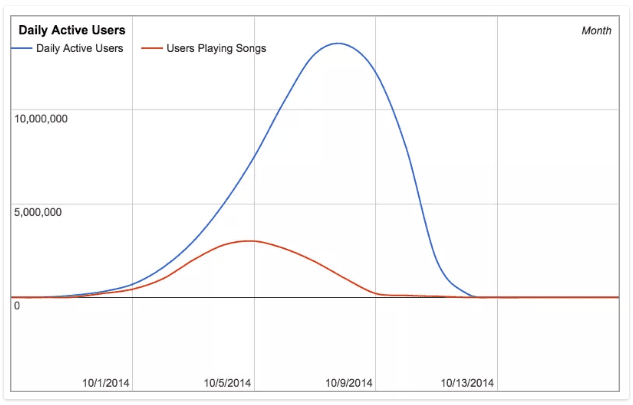Who Are Your Active Users? Strategies for User Analysis
To encourage retention, and ultimately growth, you not only need to how frequently users access your app but understand the depth of their use.
It has been argued that as a SaaS metric, active users leaves something to be desired. It’s easy to measure and it is cause for celebration when it surges, but it only scratches the surface of what you stand to learn from your users.
At a minimum, it doesn’t give any indication of how successful your marketing campaigns are at attracting new users. Because of this, you’re missing out on a prime opportunity to learn from your users and implement strategies that are meaningful to them and keep them engaged.
So, having said that, how should you analyze active users to get to the heart of what users need and what you can do for them?
Here we take a deep dive into user analysis strategies to measure who’s downloading your app, how they’re using it or whether they’re sticking around.
What does active user mean?
Daily active users (DAU) refers to users who engage with your app on a daily basis. You can measure this for longer periods such as weeks (weekly active users or WAU) and months (monthly active users or MAU). If you have a messaging app, DAU measures the number of users engaging with your service daily.
What DAU doesn’t tell you is who’s active in your app. There’s no insight into whether you’re engaging your target audience, you just know that people are interacting with it. Without knowing who your users are, it’s difficult to improve your product or position relevant marketing campaigns.
To start building user profiles, install software on your website or app that compiles user profiles when they submit their email address. A tool like Clearbit provides enriched data— name, location, mini bio— that you then collect and feed through an app like Segment that sends it to an analytics platform like Amplitude for review and interpretation.
Use Clearbit, Segment and Amplitude together to build user profiles.

Another way to find out more about your users is to ask them. Conduct short surveys that ask your users about themselves and why they use your app. You can also review user activity in your app to see if any behavioral patterns stand out.
Group together users who take different actions, like those who downloaded your app and uploaded pictures or played a song or sent a message, by creating behavioral cohorts. These cohorts represent groups of users you attract and let you learn about how each one distinctly uses your product. For each user group, you’ll not only see whether you’ve captured your target audience, but you’ll also see how they behave your product.
Knowing who your users are allows you to align their needs with your values. Your campaigns will be extremely targeted because, in addition to knowing the number of users coming back on a daily basis, you have a clearer picture of who they are and their needs.
How to analyze active user paths in your product
While measuring DAU gives you the absolute number of users who open your app in a day, it doesn’t tell you what they’re doing with it. Based on how you’ve defined your active users, it only shows you how many people fit that criterion. In this scenario, you may be capturing many users as ‘active’ who are not engaging with your product in a meaningful way.
DAU tells you how many users have been active in a day, but you also need to know what they do when they do open your product.
To figure this out, you need to start by laying out the ideal path or critical events for them to follow when they open up your app that truly represent activity and engagement. For a messaging app, it might look something like this:
Send message → Upload comments → Upload content
When coming up with your critical events, ask yourself a few questions:
- What actions do you want your users to consistently perform when they access your app?
- What metrics are most important?
- What user behavior will influence these metrics?
After reviewing the critical events you’ve set up, you find that after sending messages, users log off without uploading comments to messages in their network or uploading content. Now you can dig deeper to see what it is about the process that makes your users unsuccessful. By analyzing your app’s path, you’ll be in a better position to create a product that meets the needs of your target audience.
The goal here is to set up a sequence of events that users can follow— and you analyze over time—that will tell you of the users downloading and sending a message, who’s using it they way you intended, and whether to tweak processes to make your desired path clearer.
Analysis strategies that boost user retention
Because growth is important to you, user retention is paramount. The secret to achieving retention is being able to convey your app’s core values to your users quickly. If users don’t see you as an integral part of their lives, they’re not going to stick around for very long.
You want them to automatically turn to your app to solve a problem. That’s what demonstrating your core values does. Measuring DAU falls short of this because while you might see growth in numbers, you’re blind to the fact that users are dropping off.
Here you see that even though users are logging into a music streaming app at record numbers, users playing songs is low to the point usage plateaus at zero.

So how do you solve this and boost retention? Lincoln Murphy, a consultant who focuses on growth based on customer success, recommends starting by defining what active users mean to you, “the definition of “active” should build upon the value that you’re delivering to your customers.”
Simply put, figure out what you want users to get out of your product and measure it. For instance, with the messaging app, if you want users to send a message and comment on other messages sent on their network because it creates a sense of community, measure that. It’ll tell you how engaged users are within your app and whether you have a habit-forming product.
To help measure, test features that have the most impact on retention. Do users convert at a higher rate when they see step-by-step instructional pop-ups or reminder push notifications? For features that don’t help retention, figure out why and fix it before users start leaving by the masses. For example, if after sending a message users have issues with ads appearing or errors popping up, they’re not encouraged to come back.
If you have power users, figure out what keeps them coming back and entice other users to interact with those features as well. Consider publishing case studies to your blog or promoting testimonials that pique user interest.
Similarly, if you have identified groups of churned users, find out what makes them unique and what you can do to prevent new users from becoming like them.
Next, evaluate your app’s stickiness. That is, how frequently monthly active users return to your app daily. You calculate this by dividing DAU by MAU. If you have 5,000 daily active users and 8,000 monthly active users, the calculation would look like this:
5,000 DAU / 8,000 MAU = 62.5%
This means that in a month, users return to your app an average of 18 days out of 30. A high percentage means users are very engaged with your app and that monthly active users are moving closer to becoming daily active users. This analysis provides more insight into your retention curve because you know that users are consistently engaged.
Boost stickiness by practicing ongoing product iterations and monitoring how your stickiness changes over time. Even if you have a good guess as to why some users don’t come back, you have to keep re-assessing your stickiness curve. This is the only way you’ll know exactly what keeps users coming back.
Various user analysis strategies
The key to successful analysis of active users is to be clear on what DAU means to you. Different companies define it in different ways:
- Facebook: Registered users who logged into Facebook or used the messaging app
- Twitter: Registered users who follow at least 30 other accounts and have at least one follower
- LinkedIn: Measured by what they call “unique visiting members”
Find what makes the most sense for your product and begin to build a profile around who these users are. To encourage retention, and ultimately growth, you not only need to how frequently users access your app but understand the depth of their use.
This information arms you with strategies that help you attract and retain users that relate to your product because it solves a problem and demonstrates them how.
Want to learn more about analyzing, activating and retaining your users? Download the Product Analytics Playbook: Mastering Retention.


Nisha Dwivedi
Former Lead Sales Engineer, Amplitude
Nisha formerly led the Sales Engineering and Diversity teams at Amplitude. She graduated from the University of Michigan and has since learned to embrace warm weather, wine and hills.
More from Nisha




